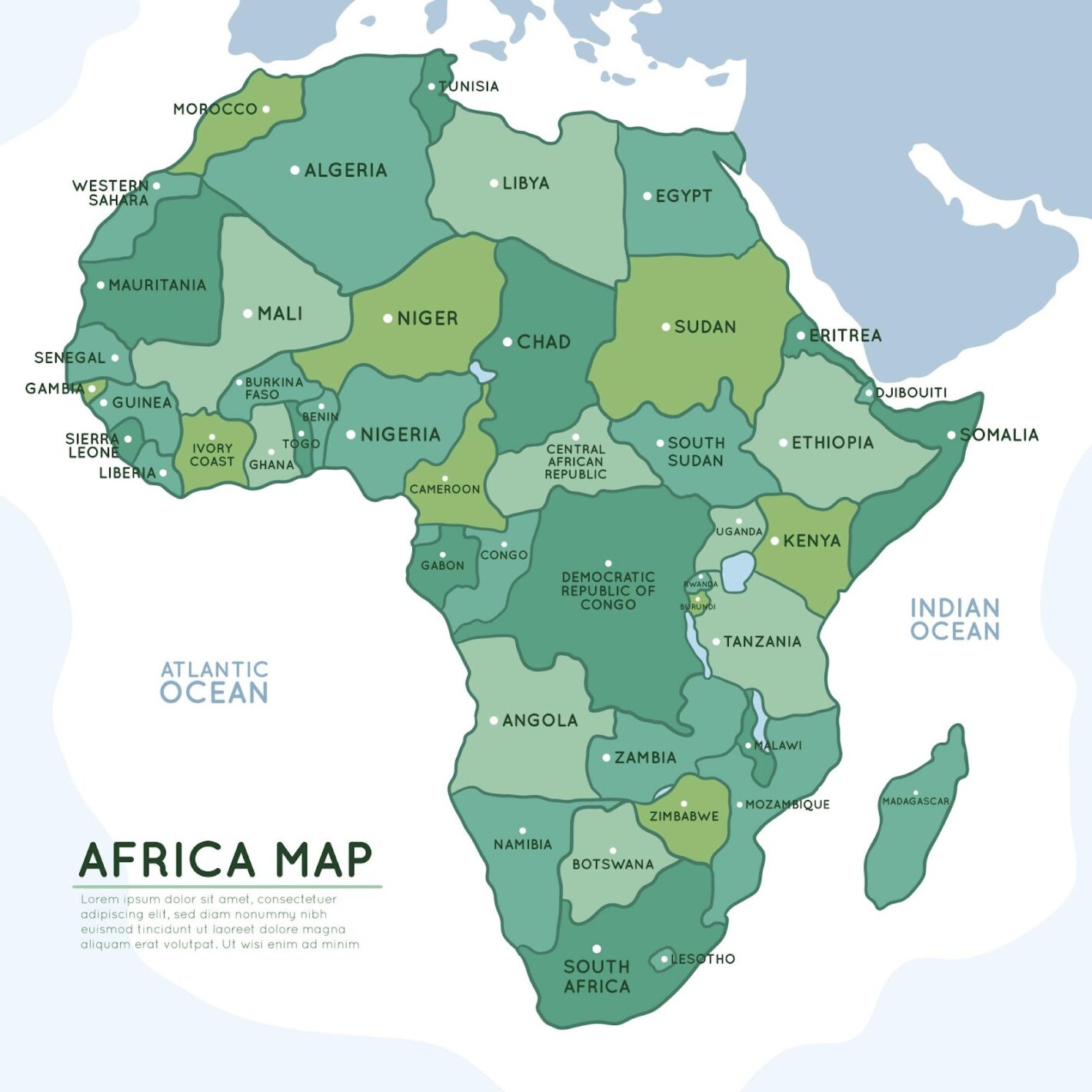Unveiling Africa’s Wealthiest: The Top 10 Richest Nations

When utilizing GDP as the yardstick, the roster of the ten most affluent nations in Africa encompasses Nigeria, South Africa, Egypt, Algeria, Morocco, Ethiopia, Kenya, Ghana, the Ivory Coast, and Tanzania. However, when the focus shifts to GNI per capita, a distinct lineup emerges.
Africa, taking its place as the second-largest and second-most densely inhabited continent following Asia, blankets a remarkable 20% of Earth’s aggregate land expanse, accommodating a populace surpassing the one billion mark. Its abundant reservoirs of commodities such as sugar, salt, diamonds, gold, and copper bestowed upon it a status of paramount allure, beckoning colonization and hegemony by foreign powers, particularly during the 1880s. This epoch, known as “the Scramble for Africa,” bore witness to the dominion of European empires like France, Belgium, Spain, Germany, and Great Britain, which wielded near-total control over the continent. The repercussions of this colonial era still cast their shadow today, with a multitude of the globe’s most impoverished nations finding their residence within Africa’s bounds. Yet, affluence also finds its abode here.
Within the confines of this discourse, we shall embark on an exploration of Africa’s ten most prosperous nations as gauged by GDP, and subsequently, we shall delve into those ranking highest based on GNI per capita, yielding an entirely distinct array of nations.
Understanding Gross Domestic Product and its Significance in Africa
Gross Domestic Product (GDP) is a pivotal financial metric used globally to evaluate the economic health of a nation. Specifically, it quantifies the total monetary value of all goods and services produced within a country’s borders in a specific time frame, typically over a year. By analyzing GDP, one gains insight into a nation’s economic performance and its comparative wealth. In Africa, a continent abundant with resources and potential, here are the top five countries by GDP:
1. Nigeria: A Powerhouse of Potential and Prosperity
Emerging from British colonial rule in 1960, Nigeria has swiftly risen to economic prominence. As of 2021, Nigeria had an impressive GDP of $440.8 billion. This economic giant is recognized for its vast natural resources, encompassing everything from valuable minerals and gemstones to abundant oil reserves. Notably, Nigeria stands out as one of the key oil producers in Africa. However, in a bid for a more sustainable future, there’s been a noticeable shift from an oil-centric economy towards other industries. For instance, the tech sector in Nigeria is rapidly blossoming, and there’s substantial potential for the country to evolve as a center for renewable energy, especially given its abundant sunlight and wind resources.
2. South Africa: A Mosaic of Economic Diversity
1994 marked a pivotal year for South Africa as it saw the termination of the oppressive apartheid regime. Economic transformations ensued, and by 2021, the nation’s GDP soared to $419 billion. Showcasing a multifaceted economy, South Africa leads in the extraction of several minerals like platinum, manganese, chromium, and vanadium. The nation’s economic framework comprises three distinct sectors:
- Primary: This encompasses agriculture, fisheries, and mining activities;
- Secondary: Encompassing sectors like manufacturing, construction, and utilities;
- Tertiary: This sector includes trades, transportation, and diverse services.
However, beneath the veneer of economic prosperity lies a pressing issue. South Africa grapples with staggering wealth inequality – a mere 10% of its population wields control over a staggering 80% of the nation’s wealth.
3. Egypt: Ancient Civilization, Modern Economy
Egypt, having broken free from British dominion in 1922, has a long-standing legacy as a fulcrum of culture and commerce. By 2021, its GDP stood at $404.1 billion. The pillars of Egypt’s economy are multifaceted. Agriculture thrives with products like cotton, sugar, and cereals taking the forefront. Additionally, tourism remains a significant contributor, thanks to the nation’s rich historical tapestry. Chemical exports and a robust manufacturing sector also add to its economic mosaic. Egypt’s strategic geographical positioning facilitates flourishing trade with other African countries and the Middle East.
4. Algeria: Fueling the Future with Diversity
Upon securing independence from France in 1962 post a tumultuous decade of conflict, Algeria’s economic trajectory has been on the upswing. With a 2021 GDP of $163 billion, Algeria is chiefly known for its extensive oil and natural gas exports. Recognizing the impermanence of fossil fuels, Algeria is steering its focus towards diversification. With ample sunlight gracing the nation, there’s a marked push towards harnessing solar energy, setting Algeria on a path to becoming a renewable energy frontrunner.
5. Morocco: Where Tradition Meets Trade
Nestled strategically between Europe and Africa, Morocco has a GDP of $142.9 billion as of 2021. This location makes it a hotspot for tourists, drawn by its mesmerizing blend of history, culture, and natural beauty. Beyond tourism, Morocco thrives on manufacturing and agriculture, with prominent exports including timber, cotton, fruits, and notably, phosphates. Holding approximately two-thirds of the global phosphate reserves, a crucial component for fertilizer production, Morocco has carved a niche for itself in the global market. Concurrently, with an eye on the future, Morocco is aggressively pursuing advancements in solar energy, aiming to be at the vanguard of this green revolution.
6. Ethiopia: A Beacon of Economic Growth in Africa
Located in the Horn of Africa, Ethiopia stands unique as the sole African nation that escaped colonization. With an impressive GDP of 111.3 billion in 2021, its economic dynamism for several years can be traced predominantly to its agricultural roots. A flourishing agro-processing industry in Ethiopia churns out a variety of processed foods, beverages, and livestock products, underlining its importance. The nation’s prowess in the textile, apparel, and leather goods sectors further accentuates its diversified economic landscape. Furthermore, it claims a historic title as the origin of coffee, a commodity that continues to be pivotal in its export lineup. Parallelly, the Ethiopian service industry is witnessing substantial growth, promising a vibrant future.
7. Kenya: East Africa’s Economic Powerhouse
Kenya, having broken free from British rule in 1963, carved a distinct economic identity for itself. Clocking a GDP of $110.3 billion in 2021, it is undeniably the heartbeat of East Africa’s economic activities. Serving as the epicenter of finance, commerce, and logistics, it has established itself as the region’s premier industrial hub. Nevertheless, the pulse of its economy still resonates with agricultural activities. The country’s mineral wealth spans titanium, gold, and a gamut of rare earth minerals. Moreover, a burgeoning tech industry and a predominantly youthful demographic indicate a transformative economic trajectory for Kenya.
8. Ghana: The Golden West African Jewel
Ghana, gracing the eighth position in richness, recorded a GDP of 77.59 billion. Globally recognized for its prolific gold reserves, it is also a key player in the export of commodities, including oil, gas, diamonds, and notably, cocoa. Teaming up with neighboring Côte d’Ivoire, the duo commands supremacy in global cocoa bean production. Parallelly, a vibrant services industry, encompassing education, health, and ICT, augments its economic stature. The nation’s political and social stability provides a reassuring foundation for a promising economic future.
9. Côte d’Ivoire: West Africa’s Agrarian Titan
Côte d’Ivoire, also known as the Ivory Coast, emerged into economic limelight with a GDP of about $70 billion in 2021. Since attaining independence in 1960, its economic growth has been robust, becoming a benchmark in West African stability. Agriculture remains at its heart, with myriad businesses venturing into the processing of commodities like rubber, cashews, cocoa, cotton, and palm oil. Cocoa, in particular, has etched Côte d’Ivoire’s reputation on the world map, consistently ranking it among the top global suppliers. The nation’s commendable handling of the COVID-19 crisis further brightens its economic prospects.
10. Tanzania: Merging Tradition with Modernization
Tanzania, with a 2021 GDP of 67.84 billion, is on a transformative journey fueled by sectors like transportation, infrastructure, manufacturing, renewable energy, agriculture, and mining. Its terrains are rich in metals such as gold and copper and minerals including phosphate and graphite. Beyond its economic assets, Tanzania is a treasure trove of natural wonders, boasting renowned national parks and the iconic Mount Kilimanjaro. While the pandemic did cast a shadow on its thriving tourism industry, the nation remains poised for resurgence and growth.
GDP vs. GNI: Unraveling the Conundrum
In our pursuit, we meticulously unveiled the upper echelons of African prosperity, encapsulated within the GDP rankings of its ten most opulent nations. Yet, beneath the surface, another yardstick beckons our attention, birthing an alternative roster: the GNI. Acronymic for Gross National Income, the GNI embodies the comprehensive pecuniary denomination of a nation’s output and its inhabitants’ earnings—be it within domestic confines or amid foreign sojourns.

Within this scholarly milieu, a choir of experts raises its voice in dissent against the unswerving veneration of GDP, proffering multifaceted criticisms that spotlight its intrinsic limitations. Unlike GNI, the GDP’s compass neglects pivotal considerations—such as the remittances nurturing familial hearths, the temporal span of economic zeniths or nadirs, and the nuanced attributes of procured commodities, intertwined with their enduringness and eminence.
The Ten Wealthiest Nations in Africa Based on Gross National Income Per Capita
Understanding the prosperity of African nations can be gleaned by observing their Gross National Income (GNI) per capita. This metric denotes the total yearly income of a nation in monetary terms, which, when divided by its population, provides an average income per citizen. Below is a more in-depth analysis of the top 5 nations in Africa with the highest GNI per capita:
1. Seychelles: The Archipelago Gem
GNI per Capita: $14,540
- Overview: Located to the northeast of Madagascar, Seychelles stands out as the most affluent nation in Africa by GNI per capita. Evaluating its GDP per capita further substantiates its eminent economic position;
- Economic Backbone: The heart of Seychelles’ economy is rooted in tourism and fisheries;
- Environmental Concern: Given its heavy reliance on the two sectors, Seychelles is considerably susceptible to the adverse effects of climate change. Rising sea levels and marine ecosystem disruptions could spell challenges for the nation in the coming years.
2. Mauritius: The Island Powerhouse
GNI per Capita: $9,920
- Overview: Achieving independence in 1968, Mauritius has grown into an upper-middle-income country;
- Economic Diversification: This island nation thrives on a plethora of sectors like textiles, tourism, seafood processing, energy, and the expanding realms of education, training, and information & community technology;
- Green Ambitions: Aiming for a greener tomorrow, Mauritius is strategizing to enhance its reliance on renewable energy sources.
3. Libya: An Oil-Rich Nation Navigating Challenges
GNI per Capita: $8,700
- Overview: By the conclusion of 2021, Libya’s robust oil and natural gas reserves placed it among the top 10 countries globally;
- Recent Struggles: The nation’s economy has been swayed by multifaceted issues, encompassing political discord, the ramifications of the global pandemic, and the conflict in Ukraine;
- Future Outlook: With aspirations to magnify its oil production twofold by 2025, Libya stands before a herculean task given the preceding challenges.
4. South Africa: A Beacon of Diversity Amid Disparities
GNI per Capita: $6,530
- Overview: South Africa showcases itself as the continent’s most developed and multifaceted economy;
- Income Inequity: Notwithstanding its economic strengths, the nation grapples with profound income disparities. Efforts to bridge this gap remain central to South Africa’s socio-economic objectives.
5. Gabon: Natural Resources and Green Initiatives
GNI per Capita: $6,440
- Overview: Gabon is endowed with an abundance of natural resources;
- Economic Pillars: Apart from being a significant oil producer, Gabon’s economy leans heavily on wood exports and mineral mining;
- Environmentally Forward: Despite its oil production, Gabon takes the lead in initiatives aiming for net-zero emissions, signifying its commitment to a balanced and sustainable future.
6. Botswana: The Diamond-Driven Dynamo
GNI per Capita: $6,430
- Economic Overview: Botswana’s rapid economic ascent can be attributed to its abundant mineral resources, predominantly diamonds;
- Economic Classification: Classified as an upper-middle-income nation, Botswana is inching closer to attaining the status of a high-income country, showcasing its continuous progression and development.
7. Equatorial Guinea: Small Yet Resource-Rich
GNI per Capita: $5,150
- Geographic Placement: Nestled in Central Africa, Equatorial Guinea might be compact in size but boasts a wealth of natural resources;
- Resource Bounty: This nation is bestowed with an array of resources, including gold, gas, oil, diamonds, and uranium, solidifying its economic base;
- Economic Resilience: Having navigated through a challenging 7-year recession, the nation displays signs of economic rejuvenation and recovery.
8. Namibia: Precious Minerals and Economic Disparities
GNI per Capita: $4,650
- Economic Foundations: Namibia’s financial backbone rests primarily on its deposits of diamonds and uranium, contributing significantly to its economic prowess;
- Socio-economic Challenge: Despite its economic strengths, Namibia is grappling with profound income disparities, earning it the title of the second most unequal nation globally.
9. Algeria: Oil, Gas, and the Pursuit of Diversification
GNI per Capita: $3,660
- Economic Mainstay: Dominated by oil and natural gas exports, Algeria’s economy has been traditionally reliant on these sectors;
- Future Goals: Recognizing the need for a more balanced economic portfolio, Algeria is gradually pivoting towards diversifying its economic sectors to ensure long-term stability and growth.
10. Eswatini: A Nexus of Agriculture and Manufacturing
GNI per Capita: Not specified
- Historical Context: Formerly christened as Swaziland, Eswatini shares significant economic and socio-political ties with its neighboring nation, South Africa;
- Economic Pillars: Eswatini’s financial health revolves around agriculture and manufacturing;
- sectors, both of which faced the brunt of the global pandemic;
- Forecasting Challenges: The foreseeable future for Eswatini’s economy is set to be influenced by an array of factors ranging from climatic variances, political dynamics, to the broader shifts in global economic growth trajectories.
Conclusion
In conclusion, the economic landscape of Africa is undergoing a significant transformation, as evidenced by the list of the top 10 richest countries on the continent. These nations have demonstrated impressive growth rates, diversification of industries, and a commitment to sustainable development. However, it is important to note that the wealth of a nation extends beyond mere GDP figures. Social and human development indicators, equitable distribution of resources, and the overall well-being of citizens should also be considered when assessing a country’s prosperity.


